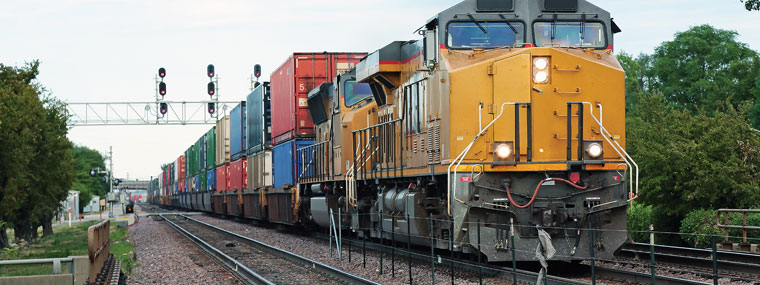
Elements of a Freight Policy
By Diane M. Calabrese / Published April 2022

Free shipping? The cost must be absorbed somewhere. Free returns? That is complicated territory.
In the last couple of months, several newspapers have reported that some retailers with no-charge shipping and free returns are losing money on the arrangement. Some customers take every advantage of the free-both-ways promise; too many customers now, it seems.
Imagine if someone in our industry ordered three different nozzles to decide which they preferred,
planning to return the other two. Does a distributor want to absorb the shipping costs?
Everyone has a vested interest in freight policy. The more efficient a shipper, the more efficient every layer that follows because optimized loads and routes cut down on related issues like fuel use.
In fact, one of the most helpful sources of guidance for evaluating and refining a freight policy comes from the Environmental Protection Agency (EPA). More information about that is provided in the last section.
Manufacturers and distributors have two fundamental goals when sending a shipment. Get the item(s) to their destination in pristine condition. Get the item(s) there on time (when the buyer expects them).
Where to begin? Start with an evaluation of the products themselves. Perhaps they can be packed or even formulated in a way that reduces the cost to move them.
“With freight costs rising, one serious consideration is looking at the weight of what you are shipping,” says Joseph Daniel, owner and CEO of ITD Inc. in Tucker, GA. “Ask the manufacturer if there is a more freight-efficient method of packaging.”
It’s a recommendation Daniel incorporates in his business. “At our company, we provide dehydrated kits and super concentrates in most of our products in order to minimize freight costs. This can really pay off if done correctly.”
Moreover, Daniel suggests that the flexibility of the manufacturer is a consideration that is significant. “If you’re not working with a manufacturer who will consult with you to be more freight-efficient with your products, then you need to find a new manufacturer.”
What is the biggest concern when developing a freight policy—timeliness of movement, damage, theft, or something else? “All of the above, but don’t forget cost,” says Daniel. “Aside from making sure you’re working with the more economical carriers, you must make sure you are reducing the weight of your freight if at all possible.”
According to the Congressional Research Service, some 43 percent of U.S. freight moves by truck. Another 27 percent moves by rail. Truck and rail—as in those trailers riding piggyback on railroad cars—accounts for another 19 percent.
Consequently, trucks and railroads carry almost 90 percent of freight. Air shipments account for one percent or less of freight movement, although it’s the fastest mode of transport.
When shipping is expedited over any distance, air and extra charges come to the fore. Customers who want the fastest shipping possible will generally be more than willing to pay for it. That’s with the exception of customers who receive an incorrect shipment and want it made right as quickly as possible.
Logistics
Entire companies are built around assisting manufacturers and distributors with the logistics of their business. Logistics firms evaluate businesses from every angle—product, source of product (or product components), customer base, etc. Not only can they help trim costs of moving goods to customers, but they can also offer ways to reduce costs of acquiring everything from boxes for shipping to hand towels for the restrooms.
Not every business in our industry is large enough to tap the expertise of a logistics firm. Still, it’s something to keep in mind. Moreover, professional organizations can and do bring in logistics experts as speakers. Seize opportunities to hear an expert.
If hiring a logistics firm is not a budgeted item, do the next best thing. Think like a logistics consultant.
“Let the data about your customer freight needs drive your direction,” says Mike Gruver, general manager at Hydrus Detergents in Estherville, IA. “Are the products Haz [hazardous and hazmat qualifying] or not? What volumes in what lanes are you shipping?”
Those are good starters. Gruver says to also ask, “Do the freight vendor contracts we have as a company align with the lane data or regional shipping needs?”
Reach out and get information from every useful source. “Don’t be afraid to contact new carrier organizations to gather feedback and information on how you ship materials,” says Gruver. “Get feedback directly from the people who ship items every day on how to be more effective.”
Transport companies of all kinds can offer ideas on how to be a more efficient shipper. Even in an economic period when such companies are under great stress, a prospective shipper can find many recommendations at their websites.
What about hiring a consultant to help streamline freight policy? “If a company doesn’t possess the internal talent with exposure to logistics management, then it may be beneficial to retain a consultant,” says Gruver.
“For a larger company with higher levels of complexity, I could see the potential of a consultant,” says Gruver. “The question is, who will own managing and improving the freight policy over time after your consultant leaves, unless you plan on a long-term retention agreement?”
Whichever path a company takes to develop or rewrite a freight policy, the policy must be subject to evaluation after it is in place. “Top measurables at our company are timeliness in given lanes, percent damage, and vendor engagement,” says Gruver.
A shipper must decide the acceptable tolerance for delivery time as well as the tolerance for damage. A vendor who is unresponsive or minimally responsive is not engaged.
By committing itself to exacting scrutiny and evaluation of its freight policy, Gruver’s company has met with good results. “Our total cost to operate has declined by focusing on what goes into effective freight movement, versus the outcome of a low-cost bid upfront,” he explains.
Optimization
What’s good for the environment is most often also good for the sender of a shipment. The shortest distance between two points, minimal but secure packaging, and fuel-efficient carriers reduce impact on the environment, and they reduce costs to businesses.
It’s not really a surprise, then, that the EPA SmartWay® program offers strategies for how shippers can optimize the movement of goods. Go to the EPA.gov website to find many guides issued by the program.
SmartWay® promotes the benefits of load planning with some numbers. For example, well-planned loads can reduce fuel costs by 5 to 15 percent. How that translates into savings for a shipper depends on its arrangement with a transport company.
Another way to save on costs, according to SmartWay®, is to join with other companies when dispatching a load. Combined- or co-loading can cut costs by as much as 20 percent, according to the EPA. Manufacturers often use some version of co-loading when they ship to distributors by consolidating items and coordinating deliveries to distributors in a specific region.
The SmartWay® program gives several examples of successful cost reductions through better planning. In one instance, a manufacturer of tiles learned it was leaving 4000-cubic-feet of space empty on each contracted rail car. It could use the space and still stay within its weight limit. In another case, a big retailer gained space on trucks it owned by using a different orientation for palletized items.
If there is one message from the SmartWay® program, it is to consider every possibility for optimizing shipping. Is the packaging unnecessarily large to protect the item? Could packages be made more uniform to save on container costs? If applicable, can the packages fit onto a pallet to minimize time in loading/unloading sequences?
Companies that use their own delivery vehicles locally can also gain by considering the configuration of their trucks and trailers. Load distribution over axles and center of gravity are both important in dispersing the weight of contents so the truck moves with greatest energy efficiency (and safely). (Aside: Contractors can also benefit from cost savings in fuel, tire wear, etc. by doing a careful evaluation of how they are loading their vehicles and using trailers.)
Depending on where a company is located, rates for shipping can vary greatly. Some manufacturers, for example, are in a region where filling backhaul spaces can yield great savings.
How does it work? Fictional company A is manufacturing pressure washer ancillaries in Midtown Manhattan. Trucks leave the heart of New York City daily after delivering their loads, and many leave empty or partly empty. Fill that space with boxes of ancillaries, and the transport company gains business—welcome to the extent that it may offer a backhaul rate.
Look at it all another way: There are as many points at which to potentially refine a freight policy—and save money—as there are points tied to freight. Even something as basic as ensuring labels and label printing are aligned properly can reduce costs by preventing misdirection of shipments.
As for free shipping, it’s probably not a sound business idea. Free returns (except to remedy a misdelivered item) are untenable in the short- and long-term.






